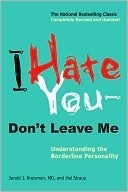More on this book
Community
Kindle Notes & Highlights
Read between
June 23 - June 24, 2020
A borderline suffers a kind of “emotional hemophilia”; she lacks the clotting mechanism needed to moderate her spurts of feeling.
Do we all display, to one degree or another, some symptoms of borderline personality? The answer is probably yes. Indeed, many of you reading this first chapter might be thinking that this sounds like you or someone you know. The discriminating factor, however, is that not all of us are controlled by the syndrome to the degree that it disrupts—or rules—our lives.
Conversely, the borderline may search for satisfaction in the opposite direction—by frequently changing jobs, careers, goals, friends, sometimes even gender. By altering external situations and making drastic changes in lifestyle, he hopes to achieve inner contentment.
If “The Truth will set you free,” then Support and Empathy must accompany it to ensure it will be heard.
As long as Rich continues to search outside himself for inner contentment, he will remain frustrated and disappointed, because he cannot control outside forces and especially others, as he can control himself.
By itself, transference is neither negative nor positive, but it is always a distortion, a projection of past emotions onto current objects.
Bibliotherapy is another therapy technique in which patients read and discuss literature, short stories, plays, poetry, movies, and videos.
All embrace communication that reflects SET-UP features that were developed by the primary author and discussed in detail in chapter 5: Support for the patient, Empathy for his struggles, confrontation of Truth or reality issues, together with Understanding of issues and a dedication to Persevere in the treatment.
The term borderline was first coined by Adolph Stern in 1938 to describe a group of patients who did not seem to fit into the primary diagnostic classifications of “neuroses” and “psychoses.”


